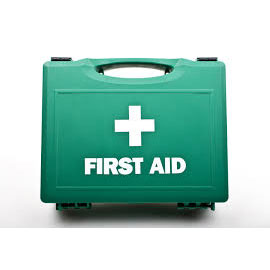
How to Implement First Aid in the Workplace
First aid is an essential consideration for all modern businesses and what you need to do depends on how large your workplace is, what the risks are, and the type of work you do.
Low-risk workplaces will need a first-aid box and somebody appointed as a first responder. They will have to implement basic first aid and call for help from emergency services if needed.
Workplaces with more risk will need fully-trained first-aiders on site at all times. First aid training courses are available from Speedy, as are mental health first aid courses.
The Health and Safety (First-Aid) Regulations 1981 require employers to provide equipment, facilities and individuals to anyone needing attention after an accident, or who is taken ill.
First Aid Needs Assessment
The majority of workplaces, especially in construction and other high-risk environments, will require a first aid needs assessment. Upon this assessment, the appointed first aiders can undertake the relevant first aid training required.
When carrying out this assessment, you need to think about:
- the type of work undertaken in your workplace
- all of the hazards and risks
- any individual health concerns of the workforce (if anyone has asthma, allergies, mental health issues etc)
- any general health concerns (such as heart attacks/strokes)
- your organisation's history of accidents, and how you have responded
- whether lone working and travelling are parts of the job
It is a good idea for first aiders to be trained on things which could occur out of the blue, such as how to use a defibrillator or treat an electric shock, as well as how to treat cuts and nosebleeds.
You also need to think about how many people will have to undertake first aid training. Consider the size of the workforce, and things like annual leave and outside responsibilities of those trained. For example, it isn't ideal if you work a flexible policy and everyone who is a first aider on site has to leave at 3 for the school pick up, or are off over the summer holidays. Also consider work patterns of staff when assigning rotas.
The Different Roles within First Aid at Work
First Aiders
There is a 'four-layer' framework when it comes to the role of everyone in the workplace and their relationship with first aid. Some are more pro-active than others, but everyone must be responsible for helping.
The layers of a 'first aider' depend on the type of workplace and risks brought up in the needs assessment. They may be:
- appointed person (AP) - calls for help
- emergency first aid at work (EFAW) - can give emergency aid to someone who falls ill or is injured on a basic level
- first aid at work (FAW) - includes EFAW and further training. Mainly for workplaces which are in the higher risk category, such as warehouses and building sites
- additional training - as appropriate to needs of the business, such as working from height response
A first aider will have undertaken the relevant training and hold certification to respond to first aid or emergency first aid incidents. Refresher courses are available to ensure skills and knowledge is up to date.
Employers
You are responsible for ensuring any injured or ill workers receive the attention they need, and you will call for the first aider. You also need to ensure first aid responses are up to date, training is up to date, new first aid needs assessments are carried out when there are changes to the workforce or workplace, and that first aid kits are suitably stocked/equipment such as defib machines are working.
You may decide you wish to be a first aider. Either way, you are in charge of appointing and assigning first aiders. You must always note that a relevant responder must be on site at all times, so if you are in charge of rotas and granting leave, always bear this in mind.
If an incident does occur, paperwork and the relevant documents will need to be assigned and updated.
Employees
As an employee who is not the first aid responder, you still have a responsibility to ensure fellow staff are safe. Check all relevant first aid responses are in place by your employer; if not, you may need to complain.
Watch out for other workers, too. You may be the first to spot if someone is in trouble, and will need to call for help. You should also bring up any worries you have regarding the way workers carry out their roles. If you spot something which you think is unsafe, a hazard or puts someone at risk, speak up.
You also need to let your employer know if you have any health issues which require either specific or general training. If you're at higher risk of heart issues, a first aider may need to be trained in response. The same applies if you're diagnosed with an illness or suffering from short-term health issues.
You also have a responsibility to carry out your job in a way which minimises risk to you and others.
Mental Health in the Workplace
Mental health is just as important as physical health, but because we can't see the struggles or effects, we often don't know how to respond (if we do at all).
It is also a good idea for any first aiders, and perhaps even all employees, to have training on how to spot mental health issues and respond. This can be something like stress, which can be brought on relatively quickly through work worries, or something pre-existing like BPD which is often diagnosed and managed.
One in four people in the UK will have a mental health problem at some point in their lives. Therefore, it is likely someone you work with lives with poor mental health. Anxiety and depression are the most common mental health problems, and anything from work issues to outside personal issues (such as bereavement or money worries) can make them worse.
Mental health worries can affect how we feel and behave. They may mean people are at higher risk of physical injury if they cannot concentrate, or struggle understanding how to carry out their role.
Employers must make adjustments to roles and workplaces under equalities legislation. Employees must also feel like they are able to be honest and open about struggles or underlying health issues.
You can read more about mental health and the workplace on the HSE website. It is a good idea for employers to ensure all other employees understand workplace mental health, for both their own care and that of those around them.
- 2024
- 2023
- December 2023 (13)
- November 2023 (9)
- October 2023 (7)
- September 2023 (10)
- August 2023 (20)
- July 2023 (21)
- June 2023 (17)
- May 2023 (17)
- April 2023 (17)
- March 2023 (14)
- February 2023 (15)
- January 2023 (7)
- 2022
- December 2022 (6)
- November 2022 (12)
- October 2022 (24)
- September 2022 (14)
- August 2022 (12)
- July 2022 (15)
- June 2022 (18)
- May 2022 (14)
- April 2022 (9)
- March 2022 (5)
- February 2022 (5)
- January 2022 (2)
- 2021
- December 2021 (7)
- November 2021 (10)
- October 2021 (1)
- September 2021 (1)
- August 2021 (3)
- July 2021 (3)
- June 2021 (4)
- May 2021 (1)
- April 2021 (1)
- March 2021 (2)
- February 2021 (1)
- January 2021 (1)
- 2020
- 2019
- 2017
- 2016
- 2014
- 2013
- 2012
- 2011


